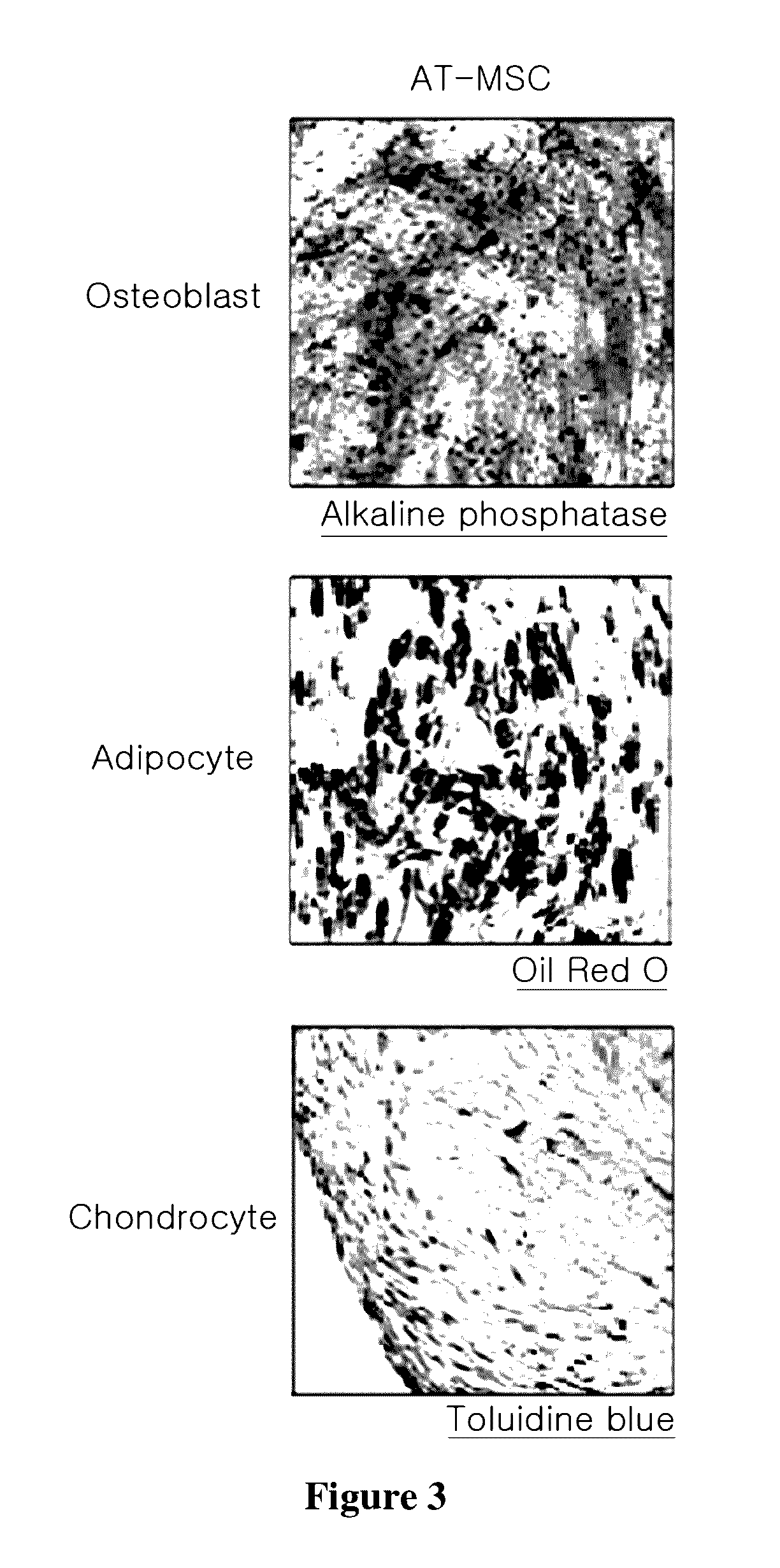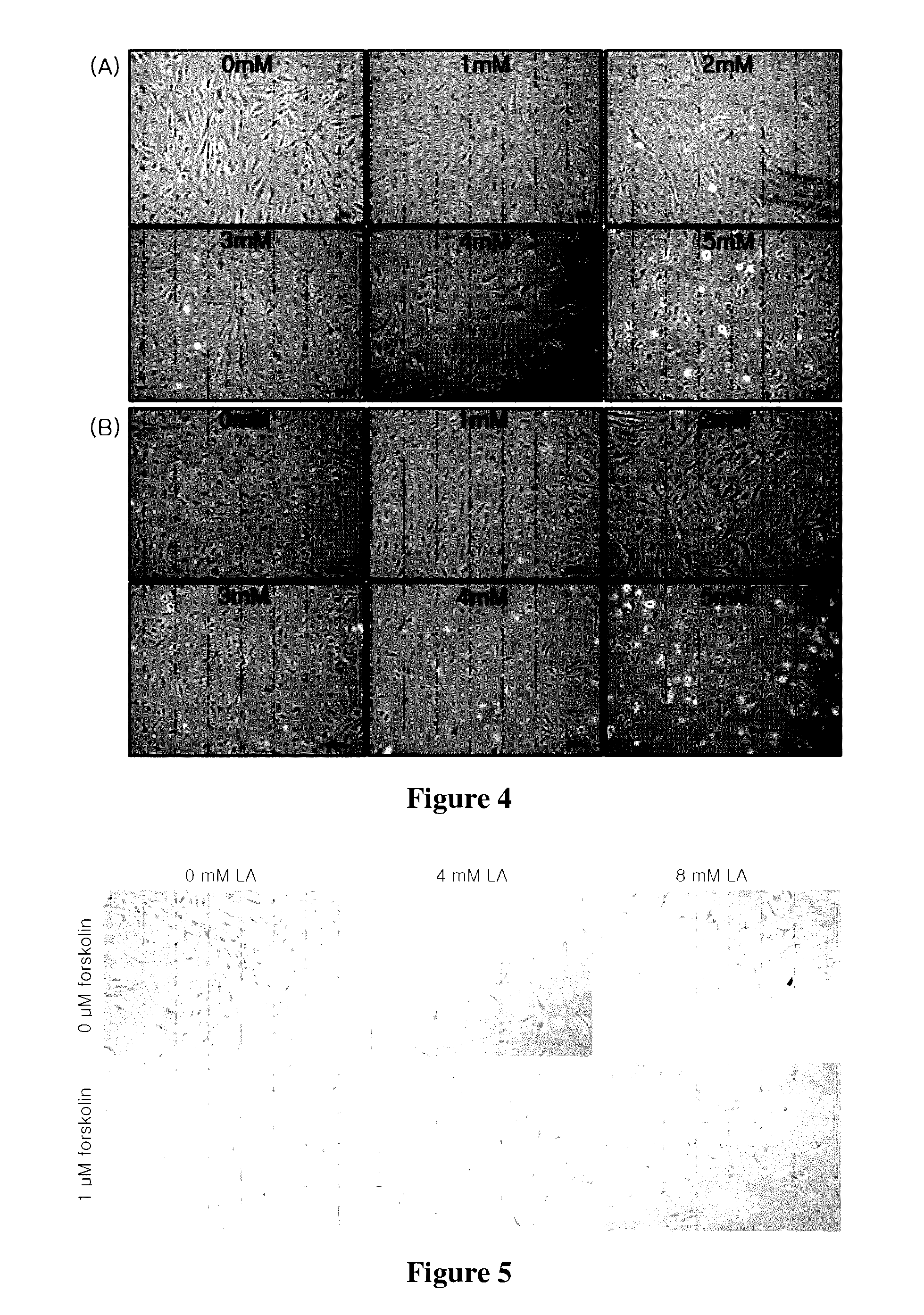Method for differentiating stem cells into neurons
a stem cell and neural cell technology, applied in the field of differentiating stem cells into neural cells, can solve the problems of high cost and time, damage to normal cells, and difficulty in conducting such studies
- Summary
- Abstract
- Description
- Claims
- Application Information
AI Technical Summary
Benefits of technology
Problems solved by technology
Method used
Image
Examples
example 1
Culture of Mesenchymal Stem Cells From Adipose Tissue
[0047]Mesenchymal stem cells obtained from adipose tissue used in this Example were StemPro® Adipose-derived Stem Cells (Product No. R7788-110) purchased from Invitrogen. Frozen ampoules were thawed, and cells were washed with DMEM, centrifuged at 800 RPM for 5 minutes, and cultured in DMEM containing low glucose (1000 mg / L) and supplemented with 10% fetal bovine serum (FBS). The cultured cells were observed, and the results are shown in FIG. 1.
[0048]As shown in FIG. 1, the cultured cells resembled fibroblasts and were maintained up to 10 generations without a decrease in proliferation. Therefore, it can be seen that the cultured cells have the morphological characteristics of mesenchymal stem cells.
example 2
Identification of Mesenchymal Stem Cells
[0049]In order to identify whether the cells cultured in Example 1 were mesenchymal stem cells, a fluorescence-activated cell sorter (FACS) analysis and an analysis of connective tissue cell differentiation capacity were performed as follows.
[0050]1. FACS Analysis
[0051]The FACS analysis with a fluorescence-activated cell sorter (BD Bioscience) showed that all of the cells were positive for markers of mesenchymal stem cells such as CD90, CD73, and CD105 and negative for markers of haematopoietic cells such as CD14, CD34, and CD45. Therefore, all of the cultured cells exhibited the expression characteristics of surface antigens of mesenchymal stem cells. The results are shown in FIG. 2.
[0052]As shown in FIG. 2, it can be seen that the activated cells expressing the surface antigens, which can be observed in mesenchymal stem cells, are uniformly distributed.
[0053]2. Connective Tissue Cell Differentiation Capacity
[0054]In order to differentiate th...
example 3
Differentiation Into Neural Cells
[0059]Mesenchymal stem cells were seeded in low glucose-Dulbecco's Modified Eagle's Medium (LG-DMEM) containing 10% fetal bovine serum (FBS) at a density of 5×103 cell / cm2. 24 hours after seeding, the medium was replaced with fresh DMEM / F-12 (1:1 mixed medium) supplemented with 1 uM hydrocortisone, 10 mg / ml insulin, 1% bovine serum albumin, and 0, 1, 2, 3, 4, 5 or 8 mM lipoic acid to induce differentiation into neural cells. Moreover, 1 uM forskolin was further added to promote differentiation into neural cells. The cellular morphology of neural cells was observed under a microscope, and the results are shown in FIGS. 4 and 5.
[0060]As shown in FIG. 4, it can be seen from the morphological changes of neural cells observed under a microscope that dendrites were well formed with lipoic acid at more than 2 mM at 5 days. However, there was no change with lipoic acid at 0 and 1 mM. This phenomenon can be confirmed by the fact that the cell viability was ma...
PUM
| Property | Measurement | Unit |
|---|---|---|
| concentration | aaaaa | aaaaa |
| concentration | aaaaa | aaaaa |
| concentration | aaaaa | aaaaa |
Abstract
Description
Claims
Application Information
 Login to View More
Login to View More - R&D
- Intellectual Property
- Life Sciences
- Materials
- Tech Scout
- Unparalleled Data Quality
- Higher Quality Content
- 60% Fewer Hallucinations
Browse by: Latest US Patents, China's latest patents, Technical Efficacy Thesaurus, Application Domain, Technology Topic, Popular Technical Reports.
© 2025 PatSnap. All rights reserved.Legal|Privacy policy|Modern Slavery Act Transparency Statement|Sitemap|About US| Contact US: help@patsnap.com



